Why Emotional Intelligence Matters for Kids
Imagine a child who can stay calm during a meltdown, put themselves in a friend’s shoes, and express how they feel in words. This isn’t an unrealistic dream – it’s the result of nurturing emotional intelligence in our children. Emotional intelligence (often called EQ) is the ability to recognize and manage one’s own emotions and understand others’ feelings. For children, a high EQ lays the foundation for strong mental health, positive relationships, and success in life (thinkacademy.capsu.edu). In fact, studies show that children with high emotional intelligence handle stress better, build meaningful relationships, and make sound decisions(thinkacademy.ca). One long-term study even found that a kindergartner’s social-emotional skills can predict their future: for every point increase in social competence, the odds of graduating college double (psu.edu). These findings make it clear – raising emotionally intelligent children is one of the greatest gifts we can give as parents.
But how can parents cultivate emotional intelligence in their kids? In this guide, we’ll explain what emotional intelligence is, why it’s so important for children, and share practical, research-backed strategies for parents (both moms and dads) to nurture these skills. From using tools like feelings posters and books to everyday empathy and communication, you’ll learn how to help your child understand their emotions, manage outbursts, and grow into a confident, compassionate individual. Let’s dive in!
As an Amazon Associate, I earn from qualifying purchases. This website is a participant in the Amazon Services LLC Associates Program, an affiliate advertising program designed to provide a means for sites to earn advertising fees by advertising and linking to Amazon.com and other affiliate links

What Is Emotional Intelligence (EQ) in Children?
Emotional intelligence is a term coined by psychologists to describe a set of emotional and social skills. In simple terms, it’s being “smart” about feelings – knowing what you feel, why you feel it, and how to handle those feelings healthily. Psychologist Daniel Goleman, who popularized the concept, outlines five core components of emotional intelligence: self-awareness, self-regulation, social skills, empathy, and motivation (brainmanager.io). In kids, these skills might look like: recognizing when they’re feeling angry or sad (self-awareness), taking a deep breath instead of hitting when upset (self-regulation), playing well with others (social skills), caring about a friend who is hurt (empathy), and staying curious or persistent in tasks (intrinsic motivation).
To a child, these concepts can be taught in very relatable ways. Think of learning emotions like learning colors. Young kids start with basics – happy, sad, mad (red, blue, yellow) – and gradually learn more nuanced feelings like frustrated, nervous, or excited (turquoise, magenta, teal!). We can help them build this “emotion vocabulary” through everyday interactions. The goal is not to have perfectly behaved kids (we all know that’s unrealistic), but to help them understand their feelings and others’ feelings. By doing so, we raise children who cope better with challenges and relate more kindly to those around them.
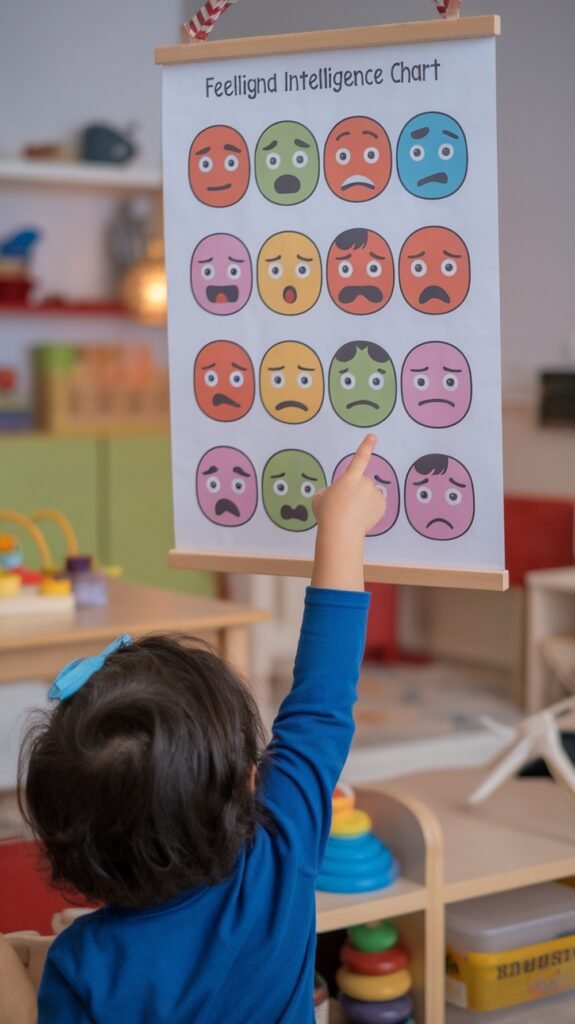
The Benefits of High Emotional Intelligence in Children
Raising a child’s EQ isn’t just a nice idea – it has real, tangible benefits backed by emotional intelligence research. Kids with higher emotional intelligence tend to handle life’s ups and downs more effectively. They can calm themselves when upset, articulate their needs, and empathize with peers. Research has linked these skills to long-term success. For example, children who are better at sharing, cooperating, and understanding feelings in kindergarten are more likely to graduate from college and hold stable jobs later on (psu.edu). On the flip side, low EQ in early childhood (difficulty managing emotions or relating to others) can foreshadow struggles in school and social settings.
Emotional intelligence also contributes to a child’s mental health and relationships. Kids who learn to cope with feelings are less prone to anxiety and depression as they grow (thinkacademy.ca). They can navigate conflicts without resorting to aggression and build positive friendships. As one parenting expert put it, establishing respect for emotion is one of the most important child-rearing tasks. When parents model and teach emotional awareness and empathy at home, children are more likely to develop resilience and compassion (thinkacademy.cathinkacademy.ca). In other words, teaching EQ is an investment in your child’s happiness and well-being.
Perhaps most importantly, emotional intelligence sets children up to become kind, confident adults. An emotionally intelligent child grows into an adult who can communicate well, work in teams, and lead with empathy – qualities highly valued in today’s world. As the saying goes, IQ might get you through school, but EQ gets you through life! By focusing on emotional growth now, you’re giving your child tools they will use forever.
(Analogous example: Think of emotional intelligence as a muscle. Just as exercise strengthens a child’s body, practicing EQ skills strengthens their “emotional muscles” – making them more adaptable and resilient when life gets tough.)

How to Raise an Emotionally Intelligent Child (Practical Strategies)
Nurturing emotional intelligence in children is a hands-on, everyday process. The good news is you don’t need fancy equipment or a PhD in psychology – just a willingness to listen, talk, and explore feelings together. Here are key strategies and tips for moms and dads to foster your child’s EQ from toddlerhood onward:
1. Help Your Child in Understanding Emotions
The first step is helping kids understand their own emotions. Young children often feel big emotions but lack the words to describe them. You can be their guide in labeling feelings. Start by talking about emotions openly at home: “I see you frowning. Are you feeling upset because your tower fell down?” or “You seem really quiet – maybe you’re feeling shy meeting new people?” By naming the emotion, you validate what your child experiences and teach them that every feeling has a name.
A great tool for this is using visual aids like a feelings chart, emotional flash cards or an emotional intelligence poster (affiliate links). Many parents hang a poster with different cartoon faces (happy, sad, angry, etc.) in the child’s room or play area. When your child seems overwhelmed, you can walk them to the chart and ask, “Can you point to what you’re feeling right now?” This simple activity empowers kids to identify their internal state. Over time, they’ll build a rich feelings vocabulary. For example, a preschooler might progress from saying “I feel bad” to “I feel frustrated because I can’t tie my shoes.”
Real-world example: Storytime can be feelings time. When reading picture books, pause to ask “How do you think this character feels?” If a character is crying because they lost a toy, help your child say, “He is sad because he lost his toy.” This not only reinforces emotion words but also builds empathy by considering others’ feelings. There are wonderful children’s books designed for this purpose. “The Way I Feel” by Janan Cain (affiliate link), for instance, uses vivid illustrations to depict different emotions, making it fun for kids to learn about feelings.
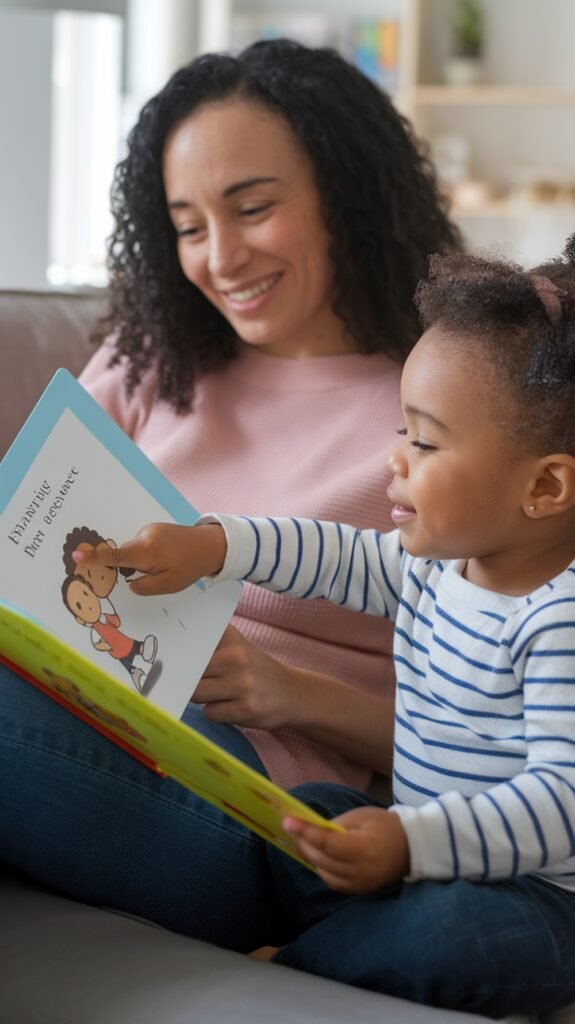
2. Teach Healthy Expression and Coping (Self-Regulation Skills)
Understanding emotions is step one; knowing what to do with those emotions is step two. Children aren’t born with self-regulation skills – we have to teach them how to cope when feelings get big. Start by showing that all emotions are okay, but not all behaviors are okay. For example, it’s okay to feel angry, but it’s not okay to hit or scream at someone. Show your child safe and constructive ways to express anger, frustration, or sadness.
One powerful method is creating a “calm-down corner” or toolkit at home. This is a cozy space (a beanbag, soft rug, or tent with pillows) where your child can go when they feel overwhelmed. Stock it with self-soothing items like a favorite stuffed animal, stress ball, coloring book or calm-down toys (affiliate link). You might include picture cards that remind them of calming strategies – like taking deep breaths, counting to 10, or softly singing a favorite song. When a tantrum is brewing or your child is on the verge of tears, gently guide them to the calm-down corner. Sit with them if they want company. Encourage them to try a coping strategy: “Let’s take three deep dragon breaths together – in through the nose, out through the mouth.” These techniques teach kids that they can take charge of their feelings. Over time, they learn to self-soothe without always needing a parent to intervene.
Another key part of healthy expression is validation. Let your child know it’s okay to have feelings. Say things like, “I know you’re really angry right now because we have to leave the park. I feel upset too when fun things end.” By hearing you reflect their feelings, children feel understood, which actually helps them calm down faster. Validating is not the same as coddling – you can acknowledge their emotion and still enforce limits. “I understand you’re mad that it’s bedtime. You wish you could keep playing. It’s normal to feel mad. And it’s still time for bed now. Maybe we can read a fun story to help you relax.” This approach shows empathy while maintaining structure.
Tip: Teach simple mindfulness exercises appropriate for kids. Even young children can learn to close their eyes and breathe deeply by imagining they are filling up a balloon in their belly. Some families use a glitter jar (a jar filled with water, glue, and glitter) – when shaken, the swirling glitter represents the child’s shaken-up feelings, and watching it slowly settle is a visual cue for them to breathe and calm down as the “feelings” settle. Such hands-on coping tools make abstract concepts tangible for little ones.

3. Model Emotional Intelligence Yourself
Children learn far more from what we do than what we say. As parents, modeling emotional intelligence in our daily behavior is incredibly powerful. This means showing your kids how you handle your own feelings and treat others with empathy. For example, if you’re feeling stressed after a long workday and your child spills juice on the floor, how you react is a live lesson. Yelling in frustration (while understandable in the moment!) might scare or confuse them. But if you take a breath and calmly say, “Oops, that was an accident. I’m a little frustrated, but let’s clean it up together,” you demonstrate self-regulation and patience. Your child sees that even grown-ups have big feelings, and we can handle them calmly.
Modeling also means apologizing when we slip up. No parent is perfect all the time – we get angry, we raise our voice or say something we regret. Instead of hoping your child forgets it, acknowledge it. A simple apology like, “I’m sorry I yelled earlier. I was frustrated, but that’s not how I should have handled it,” teaches children two things: that even adults make mistakes and that we take responsibility for our emotions. This creates a family culture where emotions aren’t hidden or denied, but addressed openly and forgiven. According to child psychologists, parents who exemplify emotional awareness raise kids who are more emotionally aware too (thinkacademy.ca). Remember, you can’t convey what you don’t exemplify – if we want respectful, empathic kids, we need to consistently show respect and empathy toward them (and other adults!) in everyday life.
Another aspect of modeling is showing empathy to others in front of your kids. Let them see you being kind and understanding. If a friend is going through a hard time, you might say in front of your child, “Our neighbor is feeling sad because his dog is very sick. We made him some cookies to cheer him up.” Small acts of kindness and discussing others’ feelings will stick with your observant little one. Over time, they will internalize that this is how we treat people.
Finally, model healthy self-care and emotional hygiene. If you’re upset, it’s okay to say, “Mom needs a five-minute break to calm down.” This signals that taking time to care for your own emotions is normal and important. Parents who look after their own emotional health tend to have more patience and energy to support their children. And as the saying goes, “happy parents raise happy children” (helpguide.org) – taking care of your feelings is part of taking care of your family.

4. Encourage Empathy and Social Skills
Empathy – the ability to understand and care about how someone else feels – is at the heart of emotional intelligence. Children are naturally egocentric (it’s just how their brains develop), but with guidance, they can learn to step into another’s shoes. Start fostering empathy by talking about others’ perspectives: “Your baby brother is crying. How do you think he feels? Why might he be sad?” Even if your child initially answers, “I don’t know,” you can gently suggest, “Maybe he’s upset because you took his toy. How can we help him feel better?” These conversations teach your child to consider emotions outside of their own experience.
One effective technique is to draw parallels to times your child felt similarly. If a friend on the playground falls down and scrapes their knee, get your child involved in caring for them. You might say, “Oh no, Jonah fell and hurt himself. Remember when you fell off your bike and scraped your knee? It hurt, and you felt scared. Jonah might feel that way now, too. What can we do to help?” Your child may offer a hug, share a toy, or simply go with you to get a bandage – all of which nurture their empathetic response. Praise these acts warmly: “That was so kind of you to help! I bet Jonah feels a lot better with you as a friend.” Positive reinforcement makes them more likely to repeat empathetic behaviors.
Playing cooperative games is a fun way to boost social skills. Choose board games or team puzzles where family members work together instead of competing like “Outfoxed” or “Race to the Treasure” (affiliate links). Kids practice taking turns, communicating, and handling both winning and losing. When conflicts pop up, guide them to talk it out. For example, if siblings fight over a toy, prompt them: “Ella, tell your brother how you feel.” She might say, “I’m mad because he grabbed it.” Then help the other respond and find a solution, like setting a timer to take turns. By mediating, you teach kids negotiation, listening, and empathy in real time.
Social stories or role-playing can be very useful if your child struggles with specific social situations (like shyness or not understanding sharing). You can role-play scenarios with dolls or puppets. For instance, act out a scene where one puppet doesn’t want to share and the other feels sad – then ask your child what each puppet could do differently. Kids often find it easier to critique or suggest ideas for a character than to apply it to themselves immediately, but those lessons will translate.
Remember, nurturing empathy also means exposing children to diversity. Read books or watch age-appropriate shows featuring characters of various backgrounds, abilities, and feelings. Discuss those differences and emphasize what feelings we all share. The more children realize “other people are like me in some ways,” the more they can empathize with classmates, neighbors, or anyone they meet.
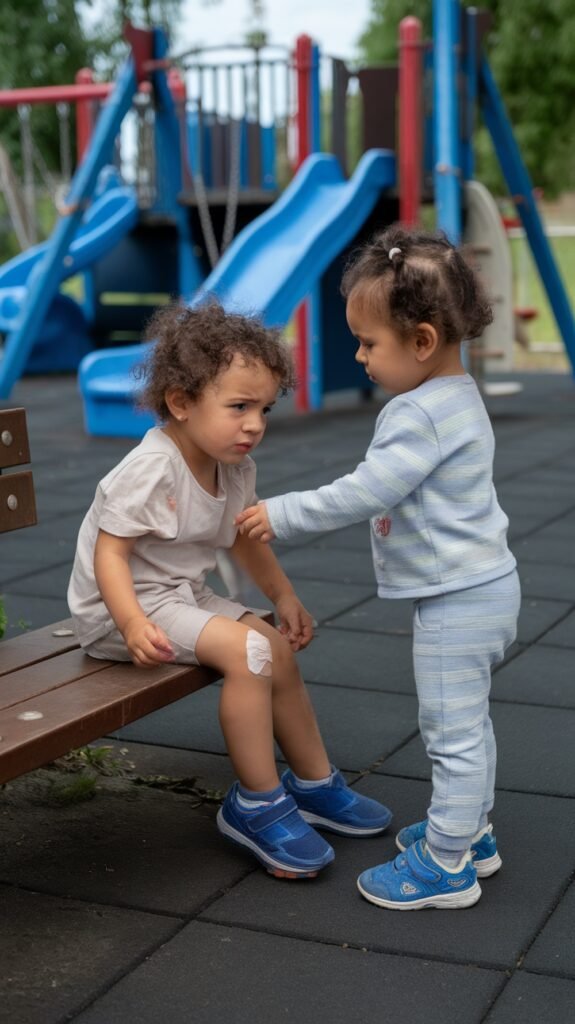
5. Use Books, Stories, and Creative Activities to Teach Emotions
Stories are a powerful teaching tool for emotional intelligence. Whether through books, movies, or even the bedtime stories you tell, children absorb lessons about feelings and relationships from narratives. Make a habit of choosing books that delve into emotions and talking about them. We mentioned “The Way I Feel” (affiliate link) as a great picture book for naming emotions. There’s also “Today I Feel Silly (and Other Moods That Make My Day)” by Jamie Lee Curtis, or “In My Heart: A Book of Feelings” by Jo Witek, among many others. As you read, engage your child with questions: “Why do you think the character felt that way? Have you ever felt like that? What helped them feel better?” These discussions build emotional literacy in a fun, low-pressure way.
Don’t overlook parenting books and resources for yourself, too. If you want to dive deeper into raising an emotionally intelligent child, classics like “Raising an Emotionally Intelligent Child” by John Gottman (affiliate link) offer insightful research and tips. Such books can guide you on emotion coaching techniques – for example, Gottman’s approach emphasizes validating your child’s feelings and guiding them to solve problems. You can treat these resources as reference material to come back to when you face a tricky parenting situation (like persistent anxieties or defiance).
Creative activities can also reinforce EQ skills. Arts and crafts provide a different outlet for emotional exploration. Try drawing or painting feelings or use an emotional activity workbook (affiliate link): “Can you draw what your anger looks like? What color is it?” A child might scribble in red for anger, and you can discuss it after: “That’s a very strong red – your anger was really big, huh?” This helps them externalize the emotion. Playdough, clay, or collage can be used to model faces with different expressions. Even a simple game like emotion charades (where each person acts out a feeling and others guess) makes learning emotions into playful fun.
Tip: Music and movement are fantastic for younger kids. Put on songs that match emotions – a fast, loud song for “angry” or a slow, gentle tune for “sad” – and have your child dance how the music makes them feel. Then talk about it: “That music was very happy and bouncy! How did your body feel when you heard it?” These multi-sensory experiences cater to kids who might not sit still for a conversation about feelings but will happily jump into an activity.
Lastly, keep the conversation going during everyday moments. At dinner, you can play a simple highs-and-lows game: everyone shares one good thing and one challenging thing about their day, and how it made them feel. This normalizes emotional sharing as a family. Your child will learn that feelings – both good and bad – can be discussed and learned from, rather than being hidden away.
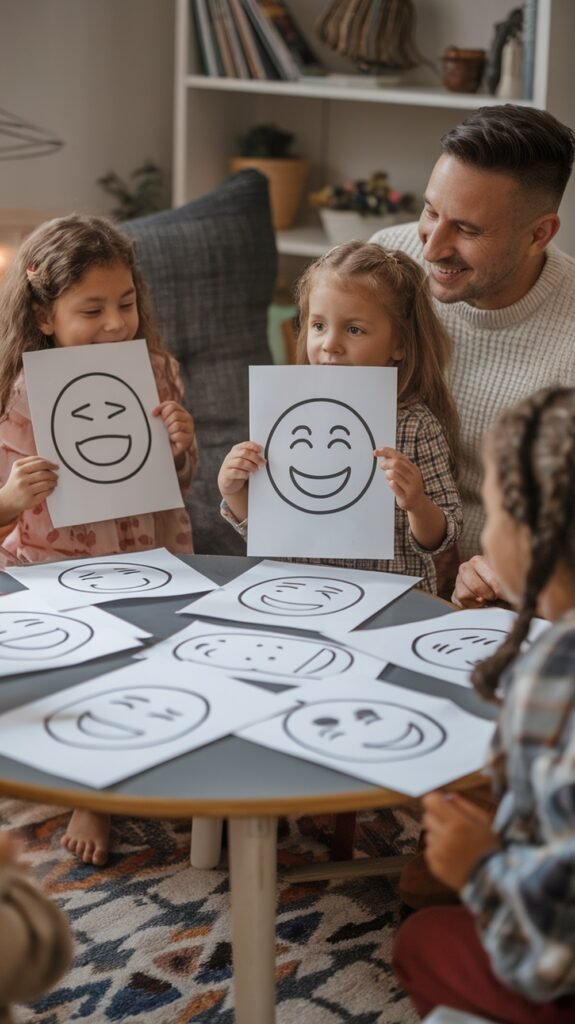
6. Be Patient and Nurturing Through the Process
Building a child’s emotional intelligence is a journey, not a one-time lesson. Patience and consistency are key. There will be days when your child reverts to tantrums despite your best emotion-coaching efforts – this is normal. Young brains are still developing impulse control. Try not to get discouraged or say “It’s not working!” in those tough moments. Instead, view setbacks as opportunities to reinforce skills. Every meltdown or sibling squabble is another chance to practice empathy, coping, and communication.
Keep a nurturing tone through the learning process. Children respond to feeling understood and loved unconditionally. When they’re in emotional pain or acting out, that’s when they most need a calm, loving parent – even if you have to fake the calm a bit! Take care of yourself so you can be that steady presence. (If you feel your own temper rising, it’s okay to step away briefly. As the HelpGuide on parenting notes, “time-out” can be for Mom and Dad, too. Taking a short break can prevent overreacting (helpguide.org.) When you return, you can approach the situation with a cooler head and an open heart.
Remember to celebrate progress. If your child successfully uses a new feeling word or shares with a friend without prompting, give specific praise: “I noticed you got angry when your block tower fell, but you didn’t scream. You took a deep breath – that’s awesome self-control!” or “You gave your friend a turn on the swing – that was very kind and shows great empathy.” Such praise reinforces the behaviors you want to see and helps your child feel proud of their growing skills.
It’s also helpful to remind yourself of the long game. You’re not just dealing with a cranky toddler or a moody tween in the moment – you’re shaping a future adult who will be calmer, kinder, and more resilient because of these lessons. Parenting with emotional intelligence in mind can be challenging, but the payoff is immense. One day, you’ll see your teenager navigate a disappointment without falling apart, or watch them comfort a peer in need, and you’ll realize all those patient conversations and hugs were worth it.
(Analogy: Think of raising an emotionally intelligent child like gardening. You plant seeds of empathy, water them with love and guidance, and patiently nurture their growth. You might not see big changes overnight, but with time, those seeds bloom into remarkable strengths.)
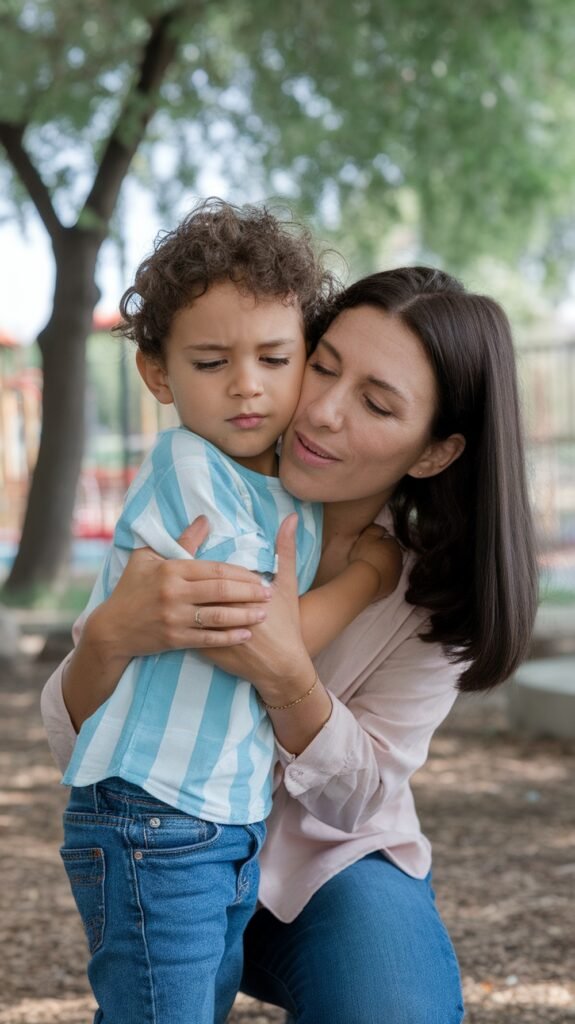
Conclusion: The Emotionally Intelligent Path to Success
In the journey of parenthood, teaching ABCs and 123s is important – but teaching empathy, self-awareness, and emotional resilience is essential. Emotional intelligence is the social glue and inner compass that will guide your child through school, friendships, and eventually the working world. By raising an emotionally intelligent child, you’re not only reducing tantrums or sibling fights in the short term; you’re equipping your son or daughter with skills that will help them thrive for a lifetime. High-EQ children grow into adults who can navigate setbacks, collaborate with others, and lead with kindness and confidence.
To recap, focus on understanding emotions, healthy expression, modeling, empathy, and consistent practice. Use the tools at your disposal – be it a handy emotions poster on the wall (affiliate link), a library of feelings books, or simply your own empathetic listening – to make emotional learning a natural part of daily life. As a parent, when you validate feelings and coach your child through their emotional storms, you build trust and emotional security. Remember that every child is unique; some will grasp these concepts quickly, while others need more time and repetition. Adjust your approach to your child’s temperament, and don’t hesitate to seek additional resources or professional advice if you’re struggling (sometimes a counselor or parenting class can offer new strategies and support).
In a world that can often be emotionally challenging, having a high EQ is like having a superpower. By raising an emotionally intelligent child, you’re giving your kid that superpower – one that will help them form deeper relationships, make wiser decisions, and maintain a positive outlook even when times get tough. It’s a gift that truly keeps on giving. So take a deep breath, put these strategies into practice one by one, and enjoy the beautiful growth you’ll witness. Your patience, love, and guidance are shaping an emotionally healthy human being – and there’s nothing more rewarding than that for a parent.

FAQ: Raising Emotionally Intelligent Kids
Q1: What is emotional intelligence in a child, and why is it important?
A: Emotional intelligence refers to a child’s ability to understand and manage their own feelings, as well as recognize and respond to the emotions of others. It’s important because it helps children manage stress, work cooperatively with peers, and communicate effectively. Kids with high emotional intelligence tend to do better in social situations and can even perform better academically (thinkacademy.ca). In the long run, these skills set them up for happier relationships and success in adulthood.
Q2: At what age can I start teaching my child emotional intelligence?
A: It’s never too early to start. Even toddlers can begin learning simple emotional skills, like naming basic feelings (“happy,” “sad,” “mad”). For example, you can start around age 2 by labeling their feelings – “I see you’re angry because we have to leave the park.” Young children won’t master self-control overnight, but consistently teaching and modeling these concepts from toddlerhood onward will steadily build their EQ. As they grow, you can introduce more complex skills (like empathy or problem-solving) in age-appropriate ways.
Q3: What are some activities to develop emotional intelligence in children?
A: There are many fun activities and games to boost EQ:
- Emotion Charades: Act out different emotions and have your child guess them (and vice versa). This playfully builds emotion recognition.
- Feelings Flashcards or Poster: Use a poster or flashcards with faces showing various emotions. Ask your child to pick one that matches how they feel, especially during calm moments before discussing big feelings.
- Role-Playing: Use dolls or action figures to role-play common scenarios (sharing toys, feeling scared of the dark, etc.). Practice with your child how to handle those situations and talk about feelings involved.
- Storytime Discussions: Read books about feelings and talk through the characters’ emotions to build empathy and awareness.
- Calm-Down Techniques: Practice deep breathing or yoga together when calm. This way kids use those skills when they are upset.
These activities make learning about emotions interactive and enjoyable, which helps lessons stick.
Q4: How can I tell if my child has high emotional intelligence for their age?
A: Children with higher EQ often show signs like:
- They can identify and name basic emotions in themselves (e.g., “I’m mad,” “That made me sad”) and sometimes in others.
- They recover faster using coping strategies—breathing, asking for a hug, or using words—instead of melting down.
- They show empathy by comforting friends or family and asking simple questions like “Are you okay?” when someone’s hurt.
- They have some patience and ability to wait or take turns, appropriate to their age.
- They communicate their needs or problems (“I’m too excited to sleep” or “I don’t like when you yell”) rather than only acting out.
Keep in mind that “high EQ” in a child is relative – all kids are still learning these skills. It’s also normal for children to have uneven development (maybe great at empathy but still learning self-control, or vice versa). If you notice steady progress in these areas as they grow, that’s a good indication your efforts are working.
Q5: Can emotional intelligence be taught to teenagers, or is it too late?
A: It’s never too late. While starting in childhood is ideal, teens are actually well-equipped to grasp empathy, ethical reasoning, and self-reflection. The approach just looks different: focus on open conversations, encourage them to talk without fear of overreaction, and model respectful conflict resolution. Journaling, age-appropriate books, and even movies can reinforce emotional growth. Many schools now teach social-emotional learning at this stage, proving EQ is lifelong. Since the brain’s emotional centers keep developing into the mid-20s, patience and empathy from parents are key. With support, teens can absolutely strengthen their EQ to handle friendships, academics, and life’s pressures.
Citations
Emotional Education and Its Impact on Raising Happier Children
https://www.thinkacademy.ca/blog/emotional-education-happier-generation/Early prosocial behavior good predictor of kids’ future | Penn State Universityhttps://www.psu.edu/news/research/story/early-prosocial-behavior-good-predictor-kids-futureEarly prosocial behavior good predictor of kids’ future | Penn State Universityhttps://www.psu.edu/news/research/story/early-prosocial-behavior-good-predictor-kids-futureHow to Improve Emotional Intelligence with Real Strategieshttps://brainmanager.io/blog/social/how-to-improve-emotional-intelligenceEarly prosocial behavior good predictor of kids’ future | Penn State Universityhttps://www.psu.edu/news/research/story/early-prosocial-behavior-good-predictor-kids-futureEmotional Education and Its Impact on Raising Happier Childrhttps://www.thinkacademy.ca/blog/emotional-education-happier-generation/Raising Emotionally Intelligent Children – HelpGuide.orghttps://www.helpguide.org/family/parenting/raising-emotionally-intelligent-childrenRaising Emotionally Intelligent Children – HelpGuide.orghttps://www.helpguide.org/family/parenting/raising-emotionally-intelligent-children
All Sources
